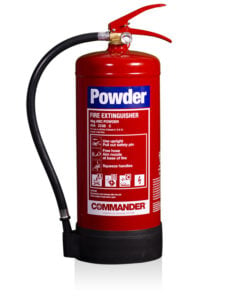Powder Fire Extinguishers: The Multipurpose Fire Safety Solution
Powder fire extinguishers, known for their versatility, are an essential component of a well-rounded fire safety strategy. Suitable for tackling Class A, B, and C fires, they offer a broad range of fire-fighting capabilities, making them a popular choice for both commercial and residential settings. Understanding the unique benefits and appropriate uses of powder extinguishers, as well as how they compare to other extinguisher types, is crucial for ensuring optimal fire safety.
The Versatility of Powder Fire Extinguishers
Powder fire extinguishers are effective against:
- Class A fires: Involving solid materials such as wood, paper, and textiles.
- Class B fires: Involving flammable liquids like petrol, oils, and paints.
- Class C fires: Involving flammable gases.
Their firefighting powder interrupts the chemical reaction that occurs in a fire, which, combined with their ability to tackle multiple fire types, makes them an invaluable tool in diverse environments.
Comparing Powder with Other Fire Extinguishers
- Foam Extinguishers: While foam is also suitable for Class A and B fires, it cannot be used on gas fires (Class C). Foam provides a cooling action suitable for liquids and solids, whereas powder extinguishers offer a quick knockdown of flames, including gas fires, but without a cooling effect.
- CO2 Extinguishers: Ideal for electrical fires and some flammable liquids, CO2 extinguishers leave no residue, making them preferable for environments with sensitive electronic equipment. Powder extinguishers, while versatile, can leave a residue that may harm sensitive equipment.
- Water Extinguishers: Best for Class A fires, offering a cooling effect on burning materials. Powder extinguishers, in contrast, provide a broader range of fire-fighting capabilities but do not cool the fire, which can be a consideration in certain fire scenarios.
- Wet Chemical Extinguishers: Specifically designed for Class F fires (cooking oils and fats), wet chemical extinguishers are the preferred choice in kitchen environments. Powder extinguishers are not suitable for these types of fires due to their inability to cool and create a secure barrier on the burning oil.
Usage and Maintenance
Using a powder fire extinguisher involves the PASS technique: Pull the pin, Aim at the base of the fire, Squeeze the handle, and Sweep the nozzle side to side. Regular maintenance, including annual servicing by a certified professional and monthly checks for damage or pressure loss, is crucial to ensure the extinguisher’s functionality in an emergency.
Conclusion
Powder fire extinguishers stand out for their versatility and effectiveness across a range of fire types. However, selecting the right fire extinguisher for your needs involves considering the specific fire risks you face. In environments with a high likelihood of electrical fires, CO2 extinguishers might be preferable, while areas with cooking oil hazards would benefit from wet chemical extinguishers. Understanding the strengths and limitations of each extinguisher type, including foam and water options, ensures comprehensive fire protection for your property.
Incorporating powder fire extinguishers into your fire safety plan offers broad protection, but it’s essential to complement them with other extinguisher types to address all potential fire risks effectively. Explore our range to find the perfect combination of fire safety solutions for your needs.













